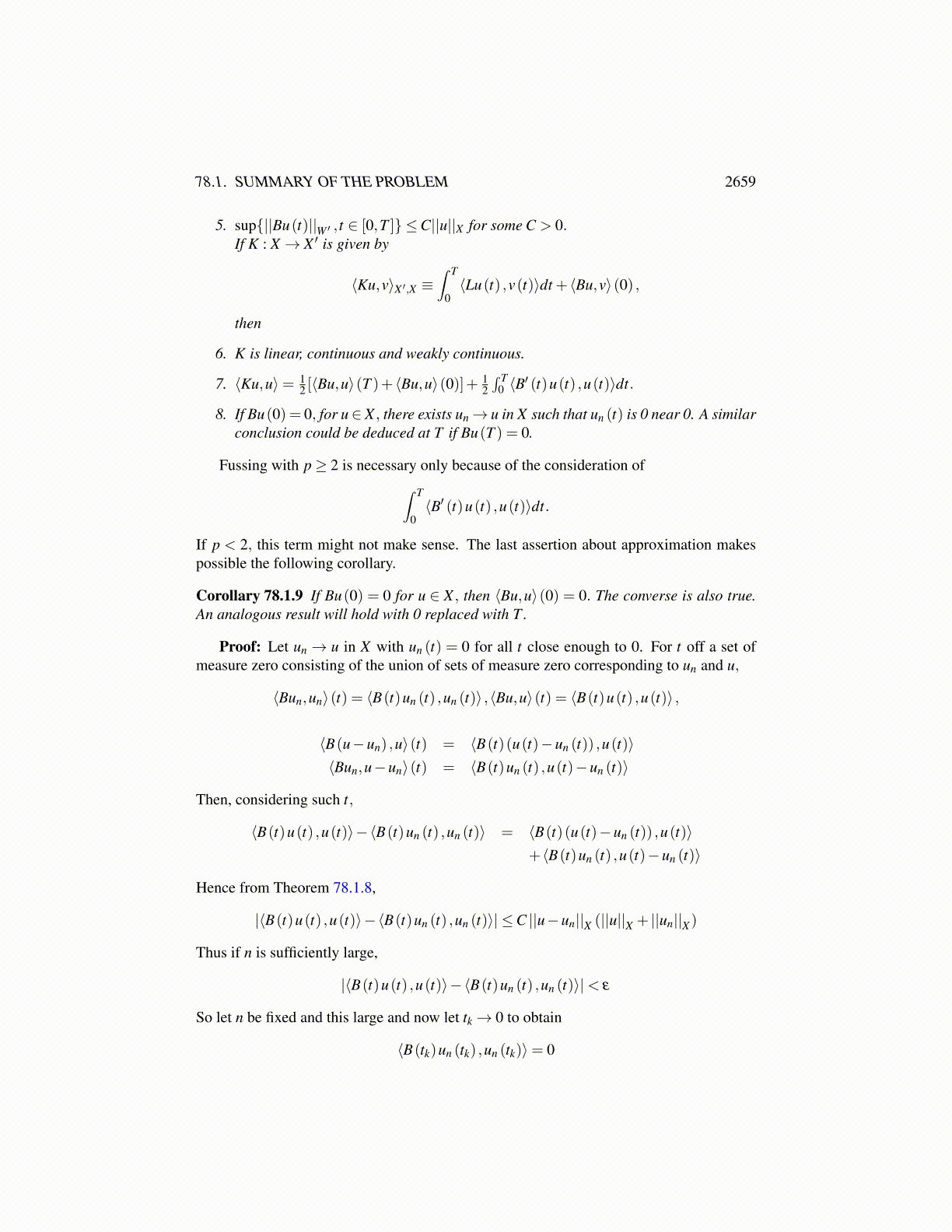
78.1. SUMMARY OF THE PROBLEM 2659
Next is what it means to be measurable into V or V ′. Such functions have representa-tives which are product measurable.
Lemma 78.1.5 Let f (·,ω)∈V ′. Then if ω→ f (·,ω) is measurable into V ′, it follows thatfor each ω, there exists a representative f̂ (·,ω) ∈ V ′, f̂ (·,ω) = f (·,ω) in V ′ such that(t,ω)→ f̂ (t,ω) is product measurable. If f (·,ω) ∈ V ′ and (t,ω)→ f (t,ω) is productmeasurable, then ω → f (·,ω) is measurable into V ′. The same holds replacing V ′ withV .
Proof: If a function f is measurable into V ′, then there exist simple functions fn
limn→∞∥ fn (ω)− f (ω)∥V ′ = 0, ∥ fn (ω)∥ ≤ 2∥ f (ω)∥V ′ ≡C (ω)
Now one of these simple functions is of the form ∑Mi=1 ciXEi (ω) where ci ∈ V ′. Therefore,
there is no loss of generality in assuming that
ci (t) =N
∑j=1
dijXFj (t)
where dij ∈ V ′. Hence we can assume each fn is product measurable into B (V ′)×F .
Then by Theorem 78.1.4, there exists f̂ (·,ω) ∈ V ′ such that f̂ is product measurable and asubsequence fn(ω) converging weakly in V ′ to f̂ (·,ω) for each ω . Thus fn(ω) (ω)→ f (ω)
strongly in V ′ and fn(ω) (ω)→ f̂ (ω) weakly in V ′. Therefore, f̂ (ω) = f (ω) in V ′ andso it can be assumed that if f is measurable into V ′ then for each ω, it has a representativef̂ (ω) such that (t,ω)→ f̂ (t,ω) is product measurable.
If f is product measurable into V ′ and each f (·,ω) ∈ V ′, does it follow that f is mea-surable into V ′? By measurability, f (t,ω) = limn→∞ ∑
mni=1 cn
i XEni(t,ω) = limn→∞ fn (t,ω)
where Eni is product measurable and we can assume ∥ fn (t,ω)∥V ′ ≤ 2∥ f (t,ω)∥. Then by
product measurability, ω → fn (·,ω) is measurable into V ′ because if g ∈ V then
ω → ⟨ fn (·,ω) ,g⟩
is of the form
ω →mn
∑i=1
∫ T
0
⟨cn
i XEni(t,ω) ,g(t)
⟩dt which is ω →
mn
∑i=1
∫ T
0⟨cn
i ,g(t)⟩XEni(t,ω)dt
and this is F measurable since Eni is product measurable. Thus, it is measurable into V ′
as desired and
⟨ f (·,ω) ,g⟩= limn→∞⟨ fn (·,ω) ,g⟩ , ω → ⟨ fn (·,ω) ,g⟩ is F measurable.
By the Pettis theorem, ω → ⟨ f (·,ω) ,g⟩ is measurable into V ′. Obviously, the conclusionis the same for these two conditions if V ′ is replaced with V .
The following theorem is also useful. It is really a generalization of the familiar GramSchmidt process. See Lemma 34.4.2 on Page 1179.